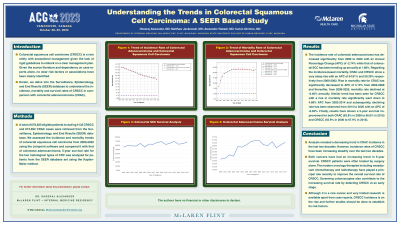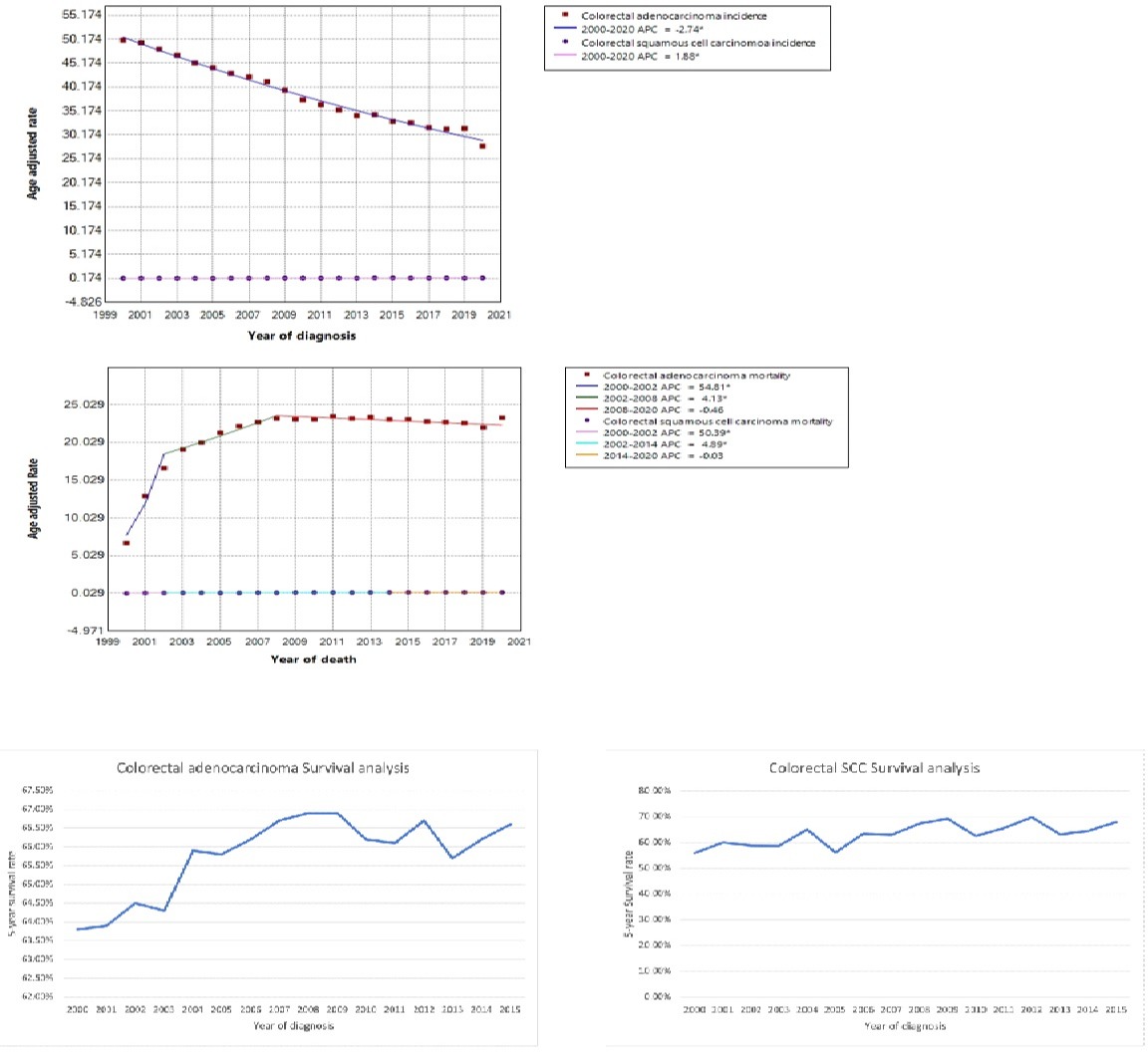Tuesday Poster Session
Category: Colon
P3015 - Understanding the Trends in Colorectal Squamous Cell Carcinoma: A SEER Based Study
Tuesday, October 24, 2023
10:30 AM - 4:00 PM PT
Location: Exhibit Hall

Has Audio

Dheeraj Alexander, MD
McLaren Flint Hospital
Flint, Michigan
Presenting Author(s)
Dheeraj Alexander, MD1, Matthew Jankowski, MD2, Alexander Rabadi, MD1, Calvin Ghimire, MD1
1McLaren Flint Hospital, Flint, MI; 2Michigan State University/McLaren Flint Hospital, Flint, MI
Introduction: Colorectal squamous cell carcinoma (CRSCC) is a rare entity with exceptional management given the lack of rigid guidelines to embark on a clear management plan. Given the scarce literature and dependency on case reports alone, no clear risk factors or associations have been clearly identified.
Herein, we delve into the Surveillance, Epidemiology, and End Results (SEER) database to understand the incidence, mortality and survival rates of CRSCC in comparison with colorectal adenocarcinoma (CRAC).
Methods: A total of 678,825 eligible patients including 4133 CRSCC and 674,692 CRAC cases were retrieved from the Surveillance, Epidemiology, and End Results (SEER) database. We assessed the incidence and mortality trends of colorectal squamous cell carcinoma from 2000-2020 using the Joinpoint software and compared it with that of colorectal adenocarcinoma. 5-year survival rate for the two histological types of colorectal cancer was analyzed for patients from the SEER database set using the Kaplan-Meier method.
Results: The incidence rate of colorectal adenocarcinoma has decreased significantly from 2000 to 2020 with an Annual Percentage Change (APC) of -2.74% while that of colorectal SCC has been trending up annually at 1.88%. Regarding the incidence-based mortality, CRAC and CRSCC show a very steep rise with an APC of 54.81% and 50.39% respectively from 2000-2002. Rise in mortality rate for CRAC has significantly decreased to APC of 4.13% from 2002-2008 and thereafter, from 2008-2020, mortality rate declined at -0.46% annually. Similar trend has been seen for CRSCC with a rise in mortality rate significantly went down to 4.89% APC from 2002-2014 and subsequently, declining rate has been observed from 2014 to 2020 with an APC of -0.03%. Finally, results have shown a 5-year survival improvement for both CRAC (63.8% in 2000 to 66.6% in 2015) and CRSCC (55.9% in 2000 to 67.9% in 2015).
Discussion: Analysis revealed a decreasing trend in CRAC incidence while that of CRSCC is rising during the last two decades. Concomitantly, both cancers have had an increasing trend in 5-year survival. Screening colonoscopies likely play a significant role in the lowering of CRAC incidence, as well as lowering both CRAC and CRSCC mortality and increasing 5-year survival, thanks in part to early detection. Although very limited research is available apart from case reports, CRSCC incidence is on the rise and further studies should be done to establish its risk factors.

Disclosures:
Dheeraj Alexander, MD1, Matthew Jankowski, MD2, Alexander Rabadi, MD1, Calvin Ghimire, MD1. P3015 - Understanding the Trends in Colorectal Squamous Cell Carcinoma: A SEER Based Study, ACG 2023 Annual Scientific Meeting Abstracts. Vancouver, BC, Canada: American College of Gastroenterology.
1McLaren Flint Hospital, Flint, MI; 2Michigan State University/McLaren Flint Hospital, Flint, MI
Introduction: Colorectal squamous cell carcinoma (CRSCC) is a rare entity with exceptional management given the lack of rigid guidelines to embark on a clear management plan. Given the scarce literature and dependency on case reports alone, no clear risk factors or associations have been clearly identified.
Herein, we delve into the Surveillance, Epidemiology, and End Results (SEER) database to understand the incidence, mortality and survival rates of CRSCC in comparison with colorectal adenocarcinoma (CRAC).
Methods: A total of 678,825 eligible patients including 4133 CRSCC and 674,692 CRAC cases were retrieved from the Surveillance, Epidemiology, and End Results (SEER) database. We assessed the incidence and mortality trends of colorectal squamous cell carcinoma from 2000-2020 using the Joinpoint software and compared it with that of colorectal adenocarcinoma. 5-year survival rate for the two histological types of colorectal cancer was analyzed for patients from the SEER database set using the Kaplan-Meier method.
Results: The incidence rate of colorectal adenocarcinoma has decreased significantly from 2000 to 2020 with an Annual Percentage Change (APC) of -2.74% while that of colorectal SCC has been trending up annually at 1.88%. Regarding the incidence-based mortality, CRAC and CRSCC show a very steep rise with an APC of 54.81% and 50.39% respectively from 2000-2002. Rise in mortality rate for CRAC has significantly decreased to APC of 4.13% from 2002-2008 and thereafter, from 2008-2020, mortality rate declined at -0.46% annually. Similar trend has been seen for CRSCC with a rise in mortality rate significantly went down to 4.89% APC from 2002-2014 and subsequently, declining rate has been observed from 2014 to 2020 with an APC of -0.03%. Finally, results have shown a 5-year survival improvement for both CRAC (63.8% in 2000 to 66.6% in 2015) and CRSCC (55.9% in 2000 to 67.9% in 2015).
Discussion: Analysis revealed a decreasing trend in CRAC incidence while that of CRSCC is rising during the last two decades. Concomitantly, both cancers have had an increasing trend in 5-year survival. Screening colonoscopies likely play a significant role in the lowering of CRAC incidence, as well as lowering both CRAC and CRSCC mortality and increasing 5-year survival, thanks in part to early detection. Although very limited research is available apart from case reports, CRSCC incidence is on the rise and further studies should be done to establish its risk factors.

Figure: Incidence, Mortality and 5-year survival rates among Colorectal adenocarcinoma (CRAC) and Colorectal Squamous cell carcinoma(CRSCC)
Disclosures:
Dheeraj Alexander indicated no relevant financial relationships.
Matthew Jankowski indicated no relevant financial relationships.
Alexander Rabadi indicated no relevant financial relationships.
Calvin Ghimire indicated no relevant financial relationships.
Dheeraj Alexander, MD1, Matthew Jankowski, MD2, Alexander Rabadi, MD1, Calvin Ghimire, MD1. P3015 - Understanding the Trends in Colorectal Squamous Cell Carcinoma: A SEER Based Study, ACG 2023 Annual Scientific Meeting Abstracts. Vancouver, BC, Canada: American College of Gastroenterology.
